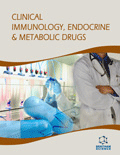Clinical Immunology, Endocrine & Metabolic Drugs (Discontinued) - Current Issue
Volume 4, Issue 1, 2017
-
-
Interferons Mediate Antiviral Immunity with Special Reference to Influenza Virus
More LessBackground: Interferons (IFNs) are functional proteins of vertebrate cells that have been conserved throughout evolution. Antiviral response in cells and uncontrolled cell proliferation of lymphocytes and macrophages are influenced by IFNs. B and T cell functions are influenced by these molecules in vitro and in vivo. These facts are confirmed by the effects on different conditions: antibodies production, T cells' cytotoxicit Read More
-
-
-
Macrogols: A Misleading Cause of Drug Hypersensitivity Diagnosis
More LessAuthors: Gianfranco Calogiuri, Caterina Foti, Maria B. Bilo and Lene Heise GarveyBackground: Polyethylene Glycols (PEGs) or macrogols are reputed to be inert and nonimmunogenic substances, however they are reported to induce immediate type hypersensitivity reactions. Due to their widespread use in extensively consumed products as cosmetics and drugs, the attention towards these substances is still low. Conclusion: Therefore, it may be useful to focus clinician's attention on possible adverse r Read More
-
-
-
The Anti-Obesity Potential of Green Tea: The Effect on Leptin and Adiponectin
More LessAuthors: Kenneth Essex and Sapha MosawyBackground: Green tea has been consumed for thousands of years, and has been known to have many medicinal properties such as, anti-cancerous, anti-atherogenic, anti-oxidative, antiinflammatory and anti-bacterial. With the increasing prevalence of Cardiovascular Disease (CVD), and its major risk factor, obesity, there has been increasing interest in green tea as a potential antiobesity therapy. Evidence has demon Read More
-
-
-
Coffee: A Rich Source of Antimicrobial and Antiviral Compounds
More LessBackground: Coffee intake represents an essential tradition in many people's lives all around the world: the success of this beverage is mainly due to its unique flavour and its well-known characteristic of reducing sleep. Coffee is usually associated with caffeine, nevertheless, hundreds of other molecules are involved in the very heterogeneous composition of the beans. Many studies revealed that several of these compounds ca Read More
-
-
-
Metabolism in the Tumor Microenvironment: What is Known about Stromal and Immune Cells?
More LessAuthors: Mª C. Ocana, Beatriz Martinez-Poveda, Ana R. Quesada and Miguel Angel MedinaBackground: In the 20th century, cancer metabolism has been studied from different aspects. In the last decade, the interest in this issue has been renewed and many studies have been carried out on tumor and endothelial metabolism. Although tumor metabolism is well recognized, there are some discrepancies between what we knew and what has been studied lately about the metabolism of endothelial cells. Moreover, canc Read More
-
-
-
Immunological and Translational Aspects of Glycolytic Metabolism in Various Human Tumor Entities
More LessAuthors: Stefan Walenta, Kristina Goetze, Nadine Voelxen and Wolfgang Mueller-KlieserBackground: Previous experimental and clinical studies have shown that lactate concentrations of 10 mM and more in solid malignant tumors may inactivate cytotoxic T cells as a major component of the immune defense of the tumor host. Additionally, it has been demonstrated recently that glucose depletion within cancerous tissue to concentrations of 1 mM and less may inhibit the T cellmediated immune response, as well. Read More
-
-
-
Impacts of Fullerene on Biological Systems
More LessBackground: The discovery of fullerene by the end of 20th century has revolutionized nanoscience and nanotechnology. Since the inception of fullerene it has been one of the most attractive natural carbon molecules for the researchers from biological, biomedical fields and other varied industries. Fullerene is one of the allotropic forms of carbon. The physical and photo-electro-chemical properties of fullerene make nano Read More
-
-
-
Leukocytes and Leukocyte Subpopulations in Patients with Beta- Thalassemia referred to Shafa Hospital Ahvaz
More LessAuthors: Mehri G. Broujerdnia, Atefeh Ghodrati, Nader D. Gerdabi, Khodayar Ghorban and Wesam KootiBackground and Objective: Thalassemia is one of the most common hereditary disorders in the world, Beta thalassemia is much more diverse than the alpha type; it was estimated that about 4% to 7% of the world's population are carriers of beta thalassemia. In thalassemia, oxidative damage is increased, which causes damage to cellular components and functional disorders in the body. Oxidative injuries and stress are import Read More
-
-
-
Abdominal Obesity in Italian Adolescents from the HELENA and ALIADO Studies: A Five-Year Period of Trend
More LessBackground: Abdominal obesity in adolescents has been identified as a risk factor for occurrence of cardiovascular and metabolic diseases. Objective: To monitor abdominal obesity in Roman adolescents through a five years-period. Method: A total of 410 adolescents aged 14.5-17.9 years, living in the city of Rome, were selected from two cross-sectional studies conducted during 2006-2007 (HELENA Study) (n=198) a Read More
-
-
-
Gene Variation of Endoplasmic Reticulum Aminopeptidase 1 and Risk of Incident Type 2 Diabetes Mellitus amongst 22,718 Initially Healthy Women
More LessAuthors: Jose R. Romero, Paul M Ridker, Daniel I. Chasman and Robert Y.L. ZeeObjective: Recent studies have demonstrated the importance of Endoplasmic Reticulum Aminopeptidase 1 (ERAP1) gene variants in inflammatory conditions, including Type 1 diabetes mellitus. However, to date, no large prospective, genetic-epidemiological data are available on the relevance of ERAP1 genetic variation in the risk of non-insulin dependent diabetes. Methods: The association between 33 tag-SNPs (tSNPs) of ERAP Read More
-
Volumes & issues
Most Read This Month Most Read RSS feed
Article
content/journals/ciemd
Journal
10
5
false
en


